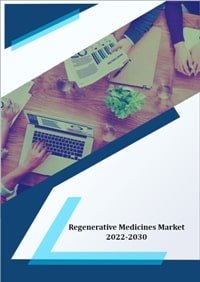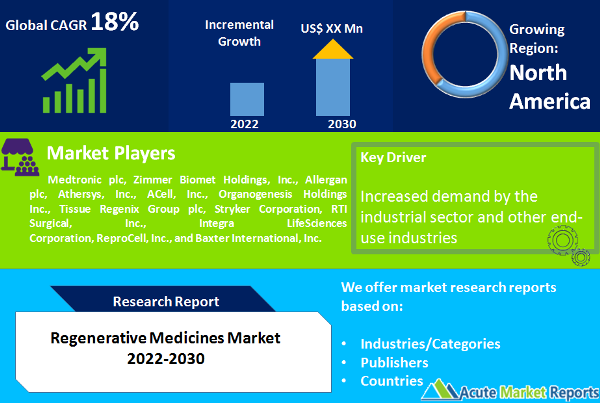
The global regenerative medicine market is expected to reach $40 billion growing at a CAGR of 18% during the forecast period 2025 to 2033. The death of organs and tissues as a result of disease or organ damage serves as a driving force behind the research and development of new medicines with the potential to regenerate tissues and lessen the need for transplantation. The field of regenerative medicine is an example of an interdisciplinary field that makes use of engineering and biological science ideas to stimulate the regeneration of organs and tissues that have been injured or damaged. The increasing prevalence of genetic and chronic illnesses is one of the primary factors that is majorly driving the growth of the market for regenerative medicine. Other factors, such as major efforts being made in medical research and development and improvements being made to healthcare infrastructure, are likely to fuel the expansion of the market. In many developed and emerging regions, the utilization of regenerative medicine requires authorization from the relevant governing bodies. In order to be marketed and sold, products related to regenerative medicine must first obtain a license or approval from the Food and Drug Administration (FDA). Therefore, the most significant obstacle to the expansion of the industry is the severe rules imposed by the government.

Increasing Geriatric Population Remains as the Key Driver
The number of people who are elderly or senior citizens is growing at a rapid rate. The World Health Organization (WHO) estimates that by the year 2050, the global population of adults aged 65 and older would have increased by around 1.5 billion. It is anticipated that the number will climb in developing nations such as China, Japan, India, and South Korea. There are a variety of health problems that are more prevalent in the elderly population, including cancer, diabetes, high blood pressure, and elevated blood sugar levels. They have a responsibility to use increased caution with regard to their health. As a direct consequence of this, people have to take their medication at predetermined intervals. The expansion of the market is also being driven by the rising number of elderly people in the world, who are more likely to experience cardiovascular and oncological issues. As a consequence of this, the growing acceptability of organ transplantation is also contributing to the expansion of the market for regenerative medicine. As a consequence of this, during the period covered by the forecast, the expanding population of elderly people would act as a primary driver of growth in the regenerative medicine market.
Expensive Nature of Treatment Hindering the Market Growth
The development of gene and cell treatments has been an enormous step forward in the treatment of individuals who are afflicted with life-threatening conditions and serious conditions. These treatments are contributing to a revolution that is taking place in the manner in which diseases are treated and cured. The demand for these therapies is significantly less than what was anticipated, despite the fact that these medicines are incredibly beneficial in terms of saving lives. This is because of the high prices of these therapies, which are hampering the expansion of the market.
Cancer Immunotherapy Promising Significant Opportunities During the Forecast Period
The development of cancer is a multi-step process that often starts with a precancerous lesion and ultimately results in a malignant tumor. Cancer is produced by the change of normal cells into tumor cells during the course of this process. These alterations are brought about by the interaction of many genetic elements within a person. The World Health Organization estimates that cancer will be the top cause of mortality worldwide, accounting for around 10 million fatalities every year by the end of 2020. A proper cancer diagnosis is absolutely necessary in order to ensure that a patient receives therapy that is both successful and suited to their particular form of the disease. Cancer is typically treated with a combination of chemotherapy, radiation, and surgery. Because of the innate capability of hematopoietic stem cells and other more mature cells, cancer immunotherapy that makes use of regenerative medicine has the distinct benefit of being able to specifically target and eradicate disease cells. In addition to this, it makes it possible to gain a deeper understanding of cancer cells, which is essential for the creation of successful treatments. As a consequence of this, increasing consumer demand for cancer treatment products, in conjunction with the growing prevalence of the condition, will produce chances for the market's expansion.
Therapeutics Topped the Product Market, While Musculoskeletal Segment Led the Application Market
In terms of the product, the therapeutics category controlled the majority of the global market for regenerative medicine in 2021, holding the greatest market share of 57%. Due to the fact that they can be utilized for a wide number of therapeutic applications, primary cell-based therapies are now the most developed drugs that are available within the therapeutics sector. With respect to the application, it is anticipated that the musculoskeletal section will be the segment that will present the most opportunities during the period of the forecast. This is because there has been an increase in the number of cases of orthopedic disorders, the number of clinical trials, the number of stem cell research projects, and the availability of a large supply of stem cell products for the treatment of musculoskeletal issues. According to the U.S. In medical facilities run by Medicare and Medicaid, there are approximately 900,000 operations performed annually that call for bone replacement or repair. Because of the annual occurrence of almost 15 million fracture cases, the cost of providing medical care in the United States is increased by USD 60 billion.
North America to Dominating the Market Revenue
In 2021, North America had the greatest revenue share, accounting for more than 41% of total revenue. The presence of a significant number of leading market players in the United States, as well as the presence of research organizations involved in the development of novel treatments and the accessibility of modern technology, all contribute to the high number of clinical trials conducted in North America. In addition, the development of cutting-edge technology for the diagnosis and treatment of chronic disorders, the accessibility of funding from both the private sector and the public sector, and increased spending on healthcare all contribute to a larger share of the regional market for tissue engineering. It is expected that the United States will account for a considerable portion of the total revenue due to the availability of cash provided by the government as well as the high investments made by private companies. In order to put regenerative medicine and stem cell therapy at the forefront of modern medical practice, the United States Department of Health has created the program known as "2020: A New Vision." The revolutionary effect that the application of regenerative medicine in clinical settings has is of the utmost significance for the progression of technological innovation and translation.
The Asia Pacific to Emerge as the Fastest Growing Region During the Forecast Period
Asia Pacific is expected to register the highest CAGR during the forecast period of 2025 to 2033. The Asia-Pacific area is the region of the regenerative medicine industry that is increasing at the highest rate. The regulatory structure has resulted in an increase in the number of clinical tests being conducted on cell-based and regenerative treatments. As a direct consequence of this, the market for regenerative medicine in the region has expanded. Increasing medical demands, an increasing population that is becoming older, and shifting lifestyles are some of the main reasons that are having an impact on the expansion of the global market for regenerative medicine in the Asia-Pacific region. The field of tissue engineering counts Japan as one of the leading countries in the world in terms of fostering technological advancement. Developed countries like the United States often outsource their tissue engineering work to Japan since the Japanese market is so competitive. Additionally, its regulatory approach is conducive to the approval of clinical trials in a more expedient manner. The Regenerative Medicine Law has been adopted by the Ministry of Health, Labor, and Welfare (MHLW), which paves the way for the adoption of processes that have the potential to speed up the clinical development of regenerative and cell-based medicines. In addition, a rise in the incidence of clinical conditions such as cancer in Asia is anticipated to be a driving force behind the expansion of the market for tissue engineering in this region. Other factors, such as the development of 3D bioprinting and the rise of medical tourism in the region, also contribute to the expansion of the industry.
Strategic Collaborations to Enhance Market Position of the Market Players
The companies Medtronic plc, Zimmer Biomet Holdings, Inc., Allergan plc, Athersys, Inc., ACell, Inc., Organogenesis Holdings Inc., Tissue Regenix Group plc, Stryker Corporation, RTI Surgical, Inc., Integra LifeSciences Corporation, ReproCell, Inc., and Baxter International, Inc. are the key players in the market for tissue engineering. Management, manufacturing, characterization, engineering, and quality control services, together with other facilities, are provided by key vendors with specialized technologies for clinical trials and other studies involved with the development of regenerative medicines. In order to achieve a competitive advantage over their rivals, key players are entering into agreements to collaborate to enhance technical expertise and market reach. In addition to this, prominent players are currently working on the creation of novel products for tissue engineering and the upgradation of their product portfolios in order to meet the demand in the current market.
Historical & Forecast Period
This study report represents analysis of each segment from 2023 to 2033 considering 2024 as the base year. Compounded Annual Growth Rate (CAGR) for each of the respective segments estimated for the forecast period of 2025 to 2033.
The current report comprises of quantitative market estimations for each micro market for every geographical region and qualitative market analysis such as micro and macro environment analysis, market trends, competitive intelligence, segment analysis, porters five force model, top winning strategies, top investment markets, emerging trends and technological analysis, case studies, strategic conclusions and recommendations and other key market insights.
Research Methodology
The complete research study was conducted in three phases, namely: secondary research, primary research, and expert panel review. key data point that enables the estimation of Regenerative Medicines market are as follows:
Market forecast was performed through proprietary software that analyzes various qualitative and quantitative factors. Growth rate and CAGR were estimated through intensive secondary and primary research. Data triangulation across various data points provides accuracy across various analyzed market segments in the report. Application of both top down and bottom-up approach for validation of market estimation assures logical, methodical and mathematical consistency of the quantitative data.
| ATTRIBUTE | DETAILS |
|---|---|
| Research Period | 2023-2033 |
| Base Year | 2024 |
| Forecast Period | 2025-2033 |
| Historical Year | 2023 |
| Unit | USD Billion |
| Segmentation | |
Product
| |
Material
| |
Application
| |
|
Region Segment (2023-2033; US$ Billion)
|
Key questions answered in this report